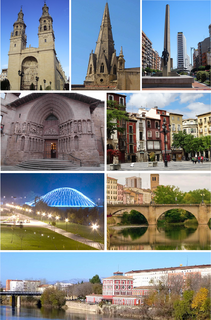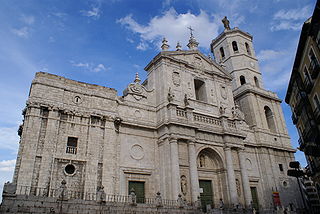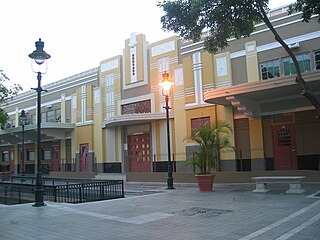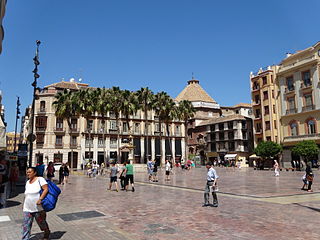
Segovia is a city in the autonomous community of Castile and León, Spain. It is the capital and most populated municipality of the Province of Segovia.

Caguas, founded in 1775, is a city and municipality of Puerto Rico located in the Central Mountain Range of Puerto Rico, south of San Juan and Trujillo Alto, west of Gurabo and San Lorenzo, and east of Aguas Buenas, Cidra, and Cayey.

Morelia is a city and the head of the municipality which has the same name in the north-central part of the state of Michoacán in central Mexico. The city is in the Guayangareo Valley and is the capital and largest city of the state. The main pre-Hispanic cultures here were the Purépecha and the Matlatzinca, but no major cities were founded in the valley during this time. The Spanish took control of the area in the 1520s. The Spanish under Viceroy Antonio de Mendoza founded a settlement here in 1541 with the name of Valladolid, which became rival to the nearby city of Pátzcuaro for dominance in Michoacán. In 1580, this rivalry ended in Valladolid's favor and it became the capital of the colonial province. After the Mexican War of Independence, the city was renamed Morelia in honor of José María Morelos, who hailed from the city. In 1991, the city was declared a UNESCO World Heritage Site for its well-preserved colonial buildings and layout of the historic center. The city population in 2020 was 743,275 inhabitants. The municipality had 849,053 inhabitants, and the Metropolitan Area, composed by Morelia, Tarímbaro, and Charo municipalities had 988,704 inhabitants, according to the XIV Census.

Logroño is the capital of the province of La Rioja and situated in northern Spain. Traversed in its northern part by the Ebro River, Logroño has historically been a place of passage – such as the Camino de Santiago.

Coyoacán is a municipality (alcaldía) of Mexico City and the former village that is now the borough's "historic center". The name comes from Nahuatl and most likely means "place of coyotes", when the Aztecs named a pre-Hispanic village on the southern shore of Lake Texcoco that was dominated by the Tepanec people. Against Aztec domination, these people welcomed Hernán Cortés and the Spanish, who used the area as a headquarters during the Spanish conquest of the Aztec Empire and made it the first capital of New Spain between 1521 and 1523. The village, later municipality, of Coyoacán remained completely independent of Mexico City through the colonial period into the 19th century. In 1857, the area was incorporated into the Federal District when this district was expanded. In 1928, the borough was created when the Federal District was divided into sixteen boroughs. The urban sprawl of Mexico City reached the borough in the mid-20th century, turning farms, former lakes, and forests into developed areas, but many of the former villages have kept their original layouts, plazas, and narrow streets and have conserved structures built from the 16th to the early 20th centuries. This has made the borough of Coyoacán, especially its historic center, a popular place to visit on weekends.

The Bolívar Square is the main square of the Colombian capital Bogotá. The square, previously called Plaza Mayor until 1821 and Plaza de la Constitución, is located in the heart of the historical area of the city and hosts a statue of Simón Bolívar, sculpted in 1846 by the Italian Pietro Tenerani, which was the first public monument in the city.

The Plaza Mayor is a major public space in the heart of Madrid, the capital of Spain. It was once the centre of Old Madrid,. It was first built (1580–1619) during the reign of Philip III. Only a few blocks away is another famous plaza, the Puerta del Sol. The Plaza Mayor is for the people of Madrid and tourists to shop, walk around, eat, and enjoy the outdoors.

Spanish Gothic architecture is the style of architecture prevalent in Spain in the Late Medieval period.

The Archdiocese of Valladolid is an ecclesiastical territory or diocese of the Catholic Church in Spain. It was erected as the Diocese of Valladolid by Pope Clement VIII on September 25, 1595, and was elevated to the rank of a metropolitan archdiocese by Pope Pius IX on July 4, 1857, with the suffragan sees of Ávila, Ciudad Rodrigo, Salamanca, Segovia, and Zamora.

Segovia Cathedral is the Gothic-style Roman Catholic cathedral located in the main square of the city of Segovia, in the community of Castile-Leon, Spain. The church, dedicated to the Virgin Mary, was built in a Gothic style in the mid-16th century.

The Ponce City Hall is a historic city hall in Ponce, Puerto Rico. It is located it the center of the city, on Calle Degetau, across from Plaza Degetau in the Ponce Historic Zone. The building serves as the seat of the executive branch of government of the Autonomous Municipality of Ponce, including the office of the Mayor of Ponce. Built in 1840, it is the oldest colonial building in the city. The building was listed on the U.S. National Register of Historic Places in 1986 as Casa Alcaldía de Ponce-City Hall.

Plaza del Mercado de Ponce or, formally, Plaza del Mercado Isabel Segunda, is a historic marketplace building in Ponce, Puerto Rico. It was inaugurated in 1863 by Ponce Mayor Don Luis de Quixano. The building was designed by famed engineer Timoteo Luberza. The Plaza occupies a city block in the Ponce Historic Zone at the grid formed by Calle Atocha, Estrella, Leon, and Castillo streets. It has room for 65 kiosks. It was originally called "Plaza del Capá."
The following is a timeline of the history of the city of Ponce, Puerto Rico.

The architecture of Madrid has preserved the look and feel of many of its historic neighbourhoods and streets, even though Madrid possesses a modern infrastructure. Its landmarks include the Royal Palace of Madrid, the Royal Theatre with its restored 1850 Opera House, the Buen Retiro Park, the 19th-century National Library building containing some of Spain's historical archives, a large number of national museums, and the Golden Triangle of Art located along the Paseo del Prado and comprising three art museums: Prado Museum, the Reina Sofía Museum, and the Thyssen-Bornemisza Museum, which completes the shortcomings of the other two museums. Cibeles Palace and Fountain have become the monument symbol of the city.

Plaza de la Constitución is a public square in the city center of Málaga, Spain.
Dragon Rapide is a 1986 Spanish historical drama film directed, written and produced by Jaime Camino, and starring Juan Diego, Vicky Peña and Manuel de Blas. It is composed by Xavier Montsalvatge. It is about the Spanish Civil War.

The Monastery of Santa Cruz la Real in Segovia, Spain, dates back to the 13th century. It has undergone several renovations and currently houses IE University. In 1985, UNESCO declared it a World Heritage Site.


















